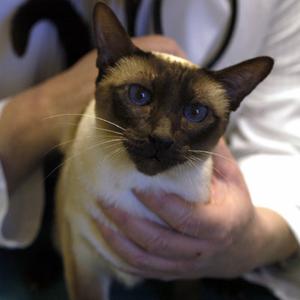For pet owners, learning that one’s beloved canine or feline companion has cancer is one of the worst imaginable conversations that can be had with their veterinarian. The diagnosis of cancer is life-altering for pets and their human caretakers. Our daily routines with our pets take on new meaning and we perpetually question “how much time do we have left.” Concerns about the financial, emotional, logistical, and energetic input required to treat a pet’s cancer create additional burden on the owner’s stressed mental state.
My Personal Experience with Canine Cancer
Not only do I convey the cancer diagnosis to my clients, but I‘ve also received the bad news for my own dog, Cardiff. As a veterinarian, my circumstance is different than that experienced by most pet owners, as I’m well aware of the challenges faced by anyone caring for their beloved canine or feline companion during cancer treatment. I’ve been involved in the process of diagnosing Cardiff’s cancer from the beginning. I actually suspected Cardiff had a stomach, intestinal, or another abdominal organ tumor based on the clinical signs signs he exhibited, including:
- anorexia (decreased appetite)
- regurgitation (bringing up partially digested food)
- lethargy (seeking rest over activity)
I also assisted on the ultrasound discovery and surgical removal of Cardiff’s intestinal mass and delivered the bad news to myself upon receiving the histopathology (microscopic evaluation of cells) report. Cardiff had T-Cell Lymphoma (malignant white blood cell cancer), but fortunately it turned out to be isolated to the loop of intestine that was surgically removed and had not spread to any other tissues. Cardiff’s cancer diagnosis wasn’t surprising to me, but the plan to put him through a 7-month-long chemotherapy course and and frequent diagnostics (blood testing, ultrasound, etc.) to increase the likelihood he'd have the best possible quality of life was quite daunting. I’m glad I put Cardiff through chemotherapy, as he’s now cancer-free and I have my urban-trekking companion back!
Pet Cancer Awareness
November is National Pet Cancer Awareness Month, so I’m striving to help owners on a world-wide basis become more aware of the clinical signs of cancer and the variety of veterinary services available to treat our canine and feline companions. Although animals and humans share some of the same cancer diagnoses, our pets cannot directly verbalize their health concerns to their owners or veterinarian. As the primary guardians of our pet’s health, we must keep a keen awareness of their day-to-day habits so that clinical signs of illness are recognized and evaluation by a veterinarian can be immediately sought. I’m fortunate to work with the esteemed team of veterinary oncologists at the Veterinary Cancer Group (VCG) in Culver City, CA. In addition to providing cutting-edge cancer diagnostic testing and treatment, VCG educates clients on early recognition of illness through their 10 Warning Signs of Cancer in Dogs & Cats, including:
- Persistent change in appetite and/or water intake
- A lump that is enlarging, changing, or waxing and waning in size
- Progressive weight loss or weight gain
- Non-healing sore or infection, such as persistent nail bed infection
- Abnormal odor
- Persistent or recurring lameness
- Chronic vomiting or diarrhea
- Persistent or recurring cough
- Unexplained bleeding or discharge
- Difficulty swallowing, breathing, urinating, or defecating
Cancer Treatment – There is Hope
The good news is that pets are surviving longer and overcoming cancer due to the numerous therapeutic options available. Cancer treatment has evolved to the extent that your pet’s disease may be resolved or well-managed through:
- Surgery - A tumor can be surgically excised (cut out) from the body so that the entire mass can be evaluated microscopically (histopathology) and a definitive diagnosis can be reached. Surgery can also completely cure cancer if the margins are clean, which means that the mass has been completely excised and no detectable cancer cells remain in the body at the surgical site.
- Radiation - Certain tumors cannot be surgically removed or cancerous cells may be left behind post-surgery if the margins extend deep into normal tissues. Therefore, radiation can be used to kill cancer cells, shrink tumor size, and improve comfort and quality of life.
- Chemotherapy - There are a vast variety of injections (intravenous or intramuscular) or oral medications that kill cancer cells. The good news for animal patients is that chemotherapy is often used in lower doses than it is for humans and has a less-toxic effect. Chemotherapy is individually tailored for each patient, as there’s no “one-size-fits-all” approach and each animal’s tolerance of the drugs is different and must be closely monitored by the veterinarian and owner for side effects.
- Nutrition - The body is best able to fight cancer when all parts are working optimally, so nutrition is a key component of cancer treatment. For all stages of a pet’s life, but especially during treatment for cancer, a whole food diet having an appropriate balance of fresh, moist meat, vegetables, fruits, and grains should be fed. Like with chemotherapy, there’s no one diet that is appropriate for all pets, so for my patients I focus on cooked foods that are either commercially available or home-prepared depending on the animal’s needs and the owner’s desires for convenience in the food-preparation process.
- Complimentary and Alternative Medicine (CAM) - CAM is the main focus of my veterinary practice when treating cancer patients. Treatments I recommend include immune system supporting and natural anti-inflammatory nutraceuticals (supplements), blood moving and anti-cancer herbal remedies, and acupressure/massage and acupuncture. Chinese medicine food energy can also help the cancer patient, as foods having cooling energetic properties are used to clear the heat caused by cancer cell division and tissue inflammation.
As cliché as it sounds, staying positive and enjoying enjoy every moment with your pet is important for everyone involved in the disease management process. With the help of a support system (veterinarians, family, friends, etc.), pet owners must face illness in their companion canine or feline with an informed sense of realism about the possible outcomes. Even if a complete cure of cancer can’t be achieved for our pets, we owe it to them to provide the best quality of life possible.






